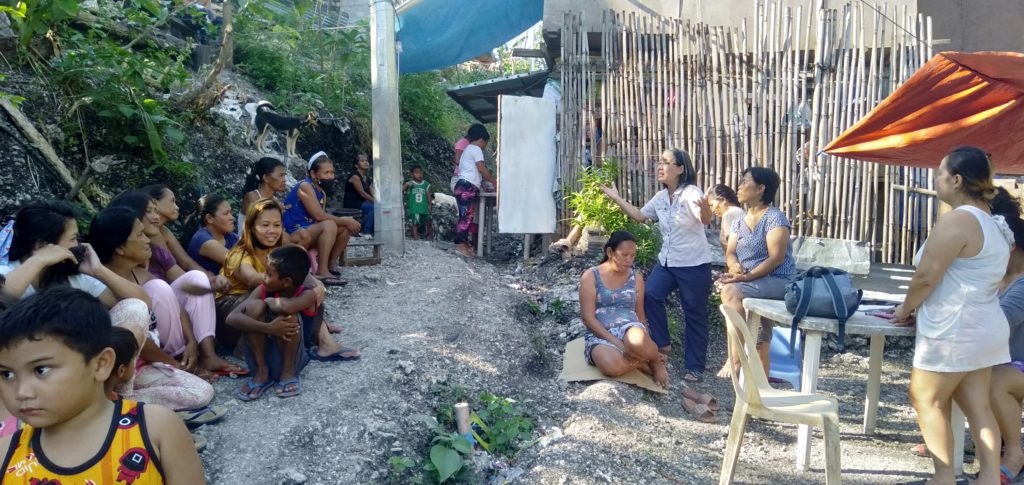The Visayas Primary Healthcare is currently in the second year of the project supported by the Committee of German Doctors’ for Developing Countries. The project started in May 2016 and shall end in April 2018. The areas include SitioSawsawan, San Roque, Talisay City, PurokTambis, Umapad, Mandaue City, and SitioIntramuros, Barangay Poblacion, Cordova
The second year of the project is geared towards our goal to develop the three communities to be self-reliant on primary health care by additional training of our community health workers (CHWs) with the necessary health skills they need in providing much needed services, raising more awareness on health among the residents and sustaining our programs on hypertension control and nutrition and environmental sanitation.
Even with the termination of the rolling clinics in all areas in Cebu and the closure of the Cebu office, the trained community health workers (CHWs) continued to render health services through home visitations, health education classes and other services gatherings in the communities.
This period also saw more families in PurokTambis relocating to the new relocation site near the Umapad Elementary School in United Nations Avenue, the highway going to the Marcelo Fernan Bridge that connects Cebu mainland and Mactan Island. There is now a total number of 150 families.
The CHWs continued to do home visitations, trying to find out who were sick and see what they can do before referring them to the German doctors, the barangay health center and government hospital and in Umapad, the Cebu Institute of Medicine community hospital in neighboring barangay Paknaan.
Blood pressure remained as a mainstay of every visit or personal encounter of the CHW with the residents. Identified hypertensive patients were checked if they were taking their medicines regularly and had their blood pressure well controlled. Most of them were. Each CHW had assigned hypertensive patients that they regularly monitored.
Anti-hypertensive medications were sold very cheaply by the CHWs in Sawsawan and Cordova; they are supplied by the supplier of medicines in the rolling clinics. Making the medicines easily accessible to the patients saves them the time and cost to go to Barangay San Roque health center or the Talisay City health center where medicines are not always available.
Malnourished children less than six years old identified during the monthly weighing by CHWs were noted to have increased their weights. Their mothers were advised on proper nutrition by the CHWs, such as giving their children more protein-rich food that are cheap, rather than only rice, dried fish, hotdog noodles, vegetables, and junk food. In PurokTambis, the Justice, Peace, and Integrity of Creation (JPIC) has regular days of the week that they have feeding of the children. Malnourished children identified greatly benefited from the feeding program.
Garden pots planted with vegetables such as alugbati(Malabar spinach),ampalaya (bitter gourd), okra (lady’s fingers) and kangkong(water spinach), are found in several houses in PurokTambis. Even with little space, the households manage to grow nutritious vegetables as part of their nutrition program.
Health educations conducted by the CHWs have also continued with old and new participants attending in order to raise their health awareness and promote healthy seeking behavior on common health issues. Leaflets on the topics are also printed and distributed to the residents.
To attract more residents to join the informal health gatherings, the CHWs cooked herbal medicine of lagundi syrup, ginger tea powder, and ointment made of temple flower, moringa and hemlock in a petroleum base. These herbal medicine have long been used for cough, stomach problems and skin infections, respectively.
On the campaign on environmental sanitation, the youth group in PurokTambis conduct clean-up drive campaigns every Sunday, collecting trash and putting them in rice sacks and bringing them to the road side to be collected by the garbage trucks. Every house has also empty sacks of rice as garbage bins. More houses, though not all yet, have already made toilet facilities made of PVC pipe connected beneath a toilet bowl to a big barrel that serves as a septic tank buried in the ground outside the house. There have been no reports of diarrheal cases in PurokTambis.



